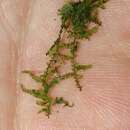en
names in breadcrumbs


Lejeunea hodgsoniana is a species of liverwort named in honour of Eliza Amy Hodgson.[1] The often extensive mats formed by L. lamacerina are composed of small (shoots up to 2 cm long and 0.5–1.5 mm wide), delicate, pale green shoots. The lobules are smaller than the broadly rounded main leaf lobes. The underleaves are rather small and distant. Often fertile, with small, 5-keeled perianths. L. cavifolia (p. 221) has relatively larger, more overlapping underleaves and relatively smaller lobules. L. patens (p. 223) has a large, inflated lobule, which makes an acute angle with the leaf lobe. L. holtii (L. eckloniana) (Paton, p. 497) is a rare plant of south-west Ireland, and has distinctly elliptical leaves, with rather small underleaves and even smaller lobules. L. mandonii (Paton, p. 500) is also very rare in oceanic districts; it is as tiny as Harpalejeunea molleri (p. 219), but has slightly elongated, rounded leaf lobes and a very distinctive, smoothly rounded perianth that differs from the 5-angled perianths of most related species. Aphanolejeunea (p. 227), Microlejeunea (p. 220), Drepanolejeunea (p. 218), etc. – are usually much smaller, with differently shaped leaves, often longer and thinner or pointed. Especially characteristic of rock faces by streams in humid valleys, and often covering extensive areas. It is far less frequent on crags or on trees in the uplands.
The species is endemic to New Zealand.[1]
![]() Data related to Lejeunea hodgsoniana at Wikispecies
Data related to Lejeunea hodgsoniana at Wikispecies
Lejeunea hodgsoniana is a species of liverwort named in honour of Eliza Amy Hodgson. The often extensive mats formed by L. lamacerina are composed of small (shoots up to 2 cm long and 0.5–1.5 mm wide), delicate, pale green shoots. The lobules are smaller than the broadly rounded main leaf lobes. The underleaves are rather small and distant. Often fertile, with small, 5-keeled perianths. L. cavifolia (p. 221) has relatively larger, more overlapping underleaves and relatively smaller lobules. L. patens (p. 223) has a large, inflated lobule, which makes an acute angle with the leaf lobe. L. holtii (L. eckloniana) (Paton, p. 497) is a rare plant of south-west Ireland, and has distinctly elliptical leaves, with rather small underleaves and even smaller lobules. L. mandonii (Paton, p. 500) is also very rare in oceanic districts; it is as tiny as Harpalejeunea molleri (p. 219), but has slightly elongated, rounded leaf lobes and a very distinctive, smoothly rounded perianth that differs from the 5-angled perianths of most related species. Aphanolejeunea (p. 227), Microlejeunea (p. 220), Drepanolejeunea (p. 218), etc. – are usually much smaller, with differently shaped leaves, often longer and thinner or pointed. Especially characteristic of rock faces by streams in humid valleys, and often covering extensive areas. It is far less frequent on crags or on trees in the uplands.